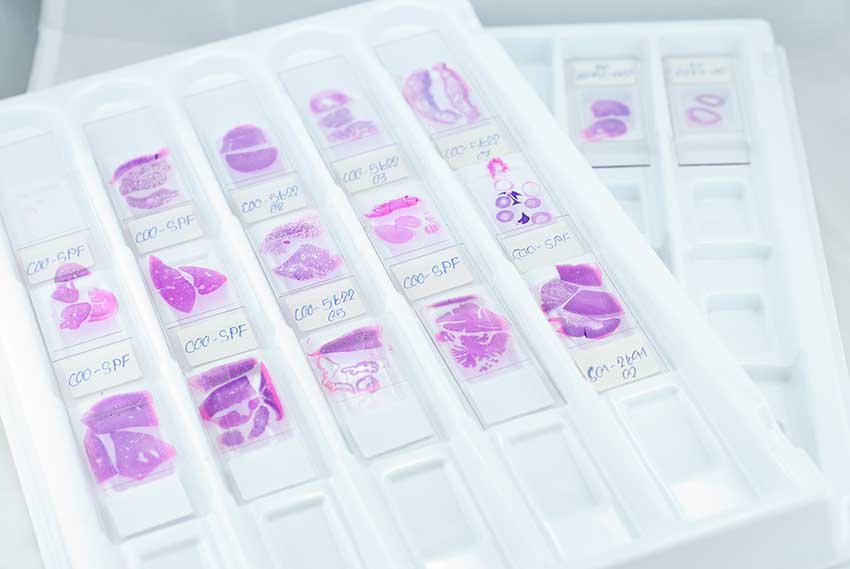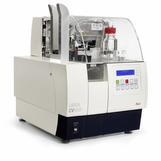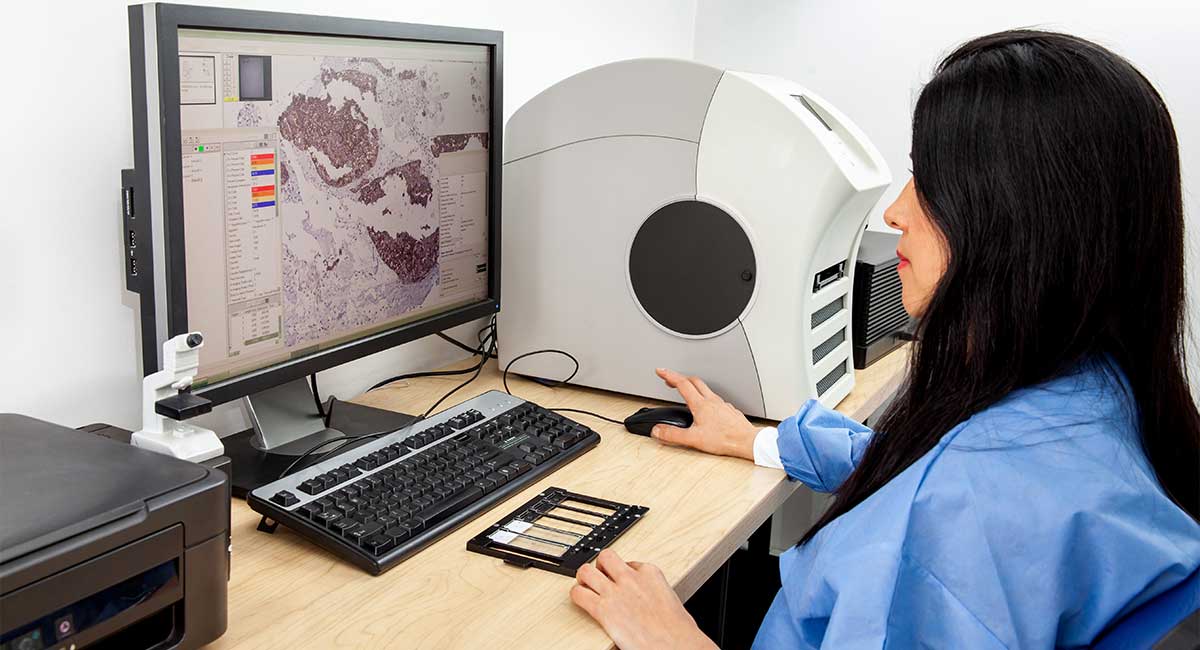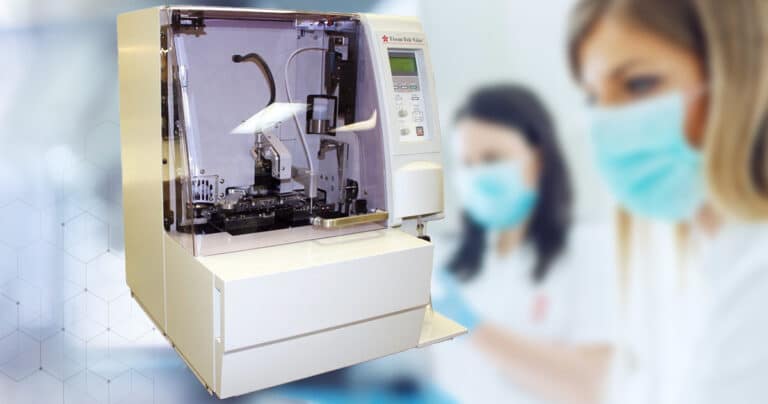Using Digital Scanners with Glass or Film Coverslippers
The transition to digital pathology has transformed how histological slides are viewed, analyzed, and shared. At the heart of this transformation are digital slide scanners—advanced tools that produce high-resolution images, supporting diagnostic accuracy and enabling remote collaboration. But for optimal performance, every component in the slide preparation workflow matters, including the choice between glass and film coverslippers.
At Mercedes Scientific, we specialize in both new and refurbished histology lab equipment. In this article, we explore how the type of coverslipper — glass or film — can impact your digital scanning results, slide preservation, and overall workflow efficiency.
Why Coverslippers Matter in Histology?
Coverslippers, whether glass or film, are more than just protective layers—they play a vital role in the quality and longevity of histological slides:
- Protection: They shield tissue sections from dust, scratches, and physical damage.
- Optical Clarity: A consistent refractive index ensures clear imaging under both microscopes and digital scanners.
- Preservation: They flatten the tissue and, when used with mounting media, help preserve slides for long-term storage and review.

The Importance of Slide Quality in Digital Pathology
Digital scanners have specific optical requirements, and slide thickness directly impacts performance:
- Why Thickness Matters: Because microscopes and digital scanners have a limited depth of field, overly thick slides can lead to parts of the tissue falling out of focus. Inconsistent thickness can also reduce image resolution and complicate automated focusing.
- Long-Term Use Standards: Clinical laboratories in the U.S., including hospital and reference labs, typically retain histology slides for at least 10 years for retrospective analysis. This makes proper slide preparation and artifact prevention critical for long-term reliability.
Glass Coverslippers: The Classic Standard
Glass coverslippers have long been the benchmark in histology labs:
- Optical Precision: Glass provides excellent clarity and is compatible with a wide range of mounting media.
- Digital Compatibility: Most scanners are designed to accept standard-sized glass coverslipped slides. However, it’s essential to ensure your coverslipper’s thickness falls within the scanner’s specifications for accurate image capture.
- Potential Drawbacks:
- Thickness Variation: Even minor inconsistencies can impact automated focus in high-throughput scanning.
- Fragility: Glass is prone to breakage during processing or scanning, which can damage equipment.
- Artifacts: Air bubbles, eosin diffusion, and yellowing can develop over time, compromising slide quality.

Featured Product
Mercedes Scientific offers high-speed glass coverslippers such as the Leica Fully Automated Glass Coverslipper. This system can process up to 300 slides per hour, supports various slide sizes and thicknesses, and promotes sustainability, — reducing water consumption in staining by up to 80%.
Film Coverslippers: The Modern Alternative
Film coverslippers, made from thin polymer materials, have become a popular option in digital workflows:
- Consistent Thickness: Their uniformity supports precise focusing and efficient image stitching in digital scanners.
- Durability: Film is resistant to cracking and shattering, reducing the risk of scanner damage.
- Reduced Artifacts: Some film coverslipping systems produce fewer air bubbles, which can improve digital image quality.
- Long-Term Stability: According to a product description of Sakura Tissue-Tek Film® Automated Coverslipper, 99.8% of slides (1,645 out of 1,648) had no artifacts. Reported artifacts, such as bubbles over tissue areas, eosin diffusion, and yellowing, were significantly reduced compared to glass. Even after 10 years of storage, film-covered slides demonstrated superior clarity and stability. Learn more.
- Considerations:
- Optical Compatibility: Film coverslippers generally offer excellent transparency, but labs should ensure they meet specific imaging needs.
- Mounting Media: Compatibility between film and mounting medium must be verified to ensure adhesion and long-term preservation.
- Scanner Requirements: While many modern scanners support film coverslipped slides, consult the manufacturer for specific guidelines.
Choosing the Right Coverslipper for Your Lab
Ultimately, the best coverslipper depends on your lab’s workflow, automation needs, and imaging requirements. Most brands offer glass coverslippers, and while each refurbished model has its own strengths and limitations, the histology equipment specialists at Mercedes Scientific can help you find the ideal fit.
- Sakura G2 Glass Coverslipper: Known as the fastest of the glass coverslipper options, the G2 features a large footprint and can be connected to the Sakura Prisma or Prisma Plus stainers. While it excels in speed and throughput, its maintenance requirements are the most extensive and tedious of the glass coverslippers.
- Leica CV5030 Glass Coverslipper: This is the most common coverslipper in labs today. Though slower than the Sakura G2, it is easier to maintain, requiring only minimal daily cleaning. It is typically connected to either the Leica ST5020 multi-stainer system or the Leica XL Autostainer (also known as ST5010) via the Leica transfer station module.
- Slee MCS Coverslipper: A newer glass coverslipper on the market, the MCS is only available when connected to the Slee MAS staining system. Maintenance requirements are similar to those of the Leica CV5030, making it a viable option for labs looking for reliable glass coverslipping without intensive upkeep.
- Sakura 4740 Film Coverslipper: Currently the fastest and highest-capacity coverslipper available, the 4740 is built for high-volume labs. It requires virtually no maintenance aside from an annual preventative maintenance (PM) visit. Its reliability, speed, and low maintenance make it a top choice among lab professionals.
- Sakura 4764 Film Coverslipper (Legacy Model): Often recognized by its distinctive bike chain drive, the 4764—commonly referred to as the Tissue-Tek Film Coverslipper—is known for its durability and minimal maintenance. Although no longer manufactured, many labs still use this model due to its tank-like reliability and legendary performance.
Maintenance Comparison: Glass vs. Film Coverslippers
Glass Coverslippers: Still the preferred choice for many pathologists due to their clarity and tradition in histology labs. However, they require more daily and routine maintenance. Some can use xylene substitutes, though these alternatives are not always recommended due to compatibility issues.
Film Coverslippers: Designed for efficiency and high-volume workflows, film coverslippers generally require less maintenance overall. However, they do require the use of xylene, and labs must ensure compatibility between the film and their mounting media.
Supporting Your Transition to Digital Pathology
Mercedes Scientific proudly offers a wide selection of refurbished and new histology lab equipment, including digital scanners and glass and film coverslippers from top manufacturers like Leica and Sakura. Our knowledgeable team can help you:
- Select scanners compatible with your coverslipping method
- Evaluate equipment based on your lab’s throughput and imaging needs
- Upgrade or expand your lab with reliable and cost-effective solutions
Whether you choose traditional glass or film, understanding the impact of coverslippers on digital scanning performance is essential. With the right combination of equipment and preparation practices, your lab can achieve clear images, reduce artifacts, and ensure long-term slide preservation.
Ready to Upgrade Your Digital Pathology Workflow?

Contact Mercedes Scientific today to speak with our histology equipment specialists and explore coverslipping and scanning solutions tailored to your lab.


